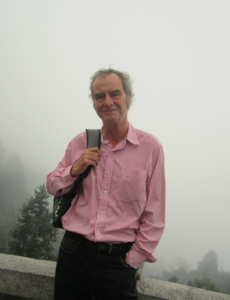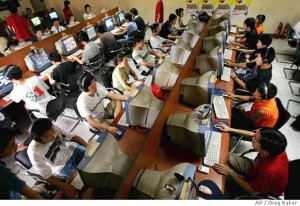PRD People: Transport Planner and Shenzhen Stalwart Mike Clark
Posted: 04/23/2014 11:00 amIf you had worked and been successful in London, Hong Kong, Singapore and New Haven, Connecticut, where would you choose to live? Englishman Mike Clark, 67, one of the world’s leading transport planners, has done all those things and decided that Shenzhen is the place where he wants to spend the rest of his life.
Clark has been a transport planner since shortly after he graduated from Bristol University in 1968 with a degree in Pure Mathematics. His career, which has also taken him to Algeria and Bolivia, saw him become one of the most sought after transport planners in the world in the 1990s, when he lived in Hong Kong.
Clark is also a well known character in Shenzhen who is known for – among other things – well-attended annual birthday parties, coining the term “YCG” (Young Chinese Girl), and having a cross-dressing alter-ego named Meimei (more on that later). This week, he took the time to talk to The Nanfang about Shenzhen, transport, ageism, and the impossibility of reintegrating after being an expat for so long.
A career in transport
Transport planning is the first stage of developing major infrastructure projects such as highways, railways, ports, and airports before or in parallel to the engineers, land use planners, economists, and other experts. He started out as a transport modeller in London before moving to Hong Kong in 1973 for his first particularly well-paid job.
“A transport model is a set of relationships which allow transport demand to be forecast from sets of input data including transport supply, socio-economic data, what are the costs of transport by various means of travel, and what transport policies are in place,” he explained to The Nanfang.
Clark left Hong Kong for Algeria in 1976 but would return several times in the eighties, most permanently in 1988 when his employer won a project called the Port and Airport Development Strategy [PADS] for the Hong Kong Strategic Planning Unit. The next decade would prove to be the most colourful period of his career.
“The project looked at ways of relocating Hong Kong’s port and airport and the necessary infrastructure and land use plans to go with those relocations. It was a very high-profile project with steering committees up to the Chief Secretary’s, and presentations to Hong Kong’s parliament, so I got a lot of exposure at the highest level,” he told The Nanfang.
Moreover, many of the government people he had worked with in the 70s and early 80s had progressed to very senior positions in the Transport Department and Transport Bureau. They knew, liked and trusted him. “As a result, our company won most of the important projects during the 90s, including Updating of the Second Comprehensive Transport Study, Electronic Road Pricing Study, Third Comprehensive Transport Study, North Lantau Development Study, and Hong Kong Airport Terminal Design,” Clark said. The common factor in all these studies was Mr. Mike Clark, so if somebody, somewhere had a transport question they would call him.
Life in Shenzhen
Despite having retired in 1999, he came to work in Shenzhen in 2003 when the consultancy he had worked for won a project called The Shenzhen Comprehensive Transport Study. He has since made a life for himself in Shenzhen. “Shenzhen suits me well now given what I want from my life, but wouldn’t have suited me in other stages. I wouldn’t want to be raising a family here for example,” said Clark.
One reason he cites for preferring Shenzhen to Hong Kong or the U.K. at this stage of life is the relative lack of ageism. “I know that I am old because I have a calendar, but I don’t want to do the things that old people are supposed to do in the UK. The western world is ageist in a way that China is not,” he opined.
His belief on the subject can perhaps best be summed up by two quotes on his Shenzhen Stuff page: “It’s not getting old that stops you doing things, it’s stopping doing things that makes you get old.” and “Honestly, I often think that it would be good to act my age, but it is so difficult.”
Enjoying the freedom of not having to act his age has led to some memorable moments in Shenzhen, many of which have involved his cross-dressing alter ego Meimei. “At fancy dress parties I usually wore a female costume from university days onwards,” he told The Nanfang when explaining how the character originated in 2009.
He discovered he could get a qipao made for 250 RMB shortly before his young adult daughters came to visit from England. “I think it’s part of a father’s duty to embarrass his daughters,” he explained.
But the most important thing keeping him in Shenzhen, along with the ease of travel for residents of the city, is the people he knows. “I can act as I wish with the friends, restaurant staff, people I meet on the metro, other expats cut adrift from their roots, whatever,” he said. His birthday parties, which are held in Huaqiangbei every December, are among the most popular annual events in Shenzhen’s English-speaking community.
Eternal expat
Although he still spends a good chunk of every year in Worcestershire, England, he is convinced that he will never be able to fit in again in his home country. Having worked overseas since 1973, he initially tried to stay in touch with school and university friends, but their lives have taken different paths. “Our life experiences and expectations were so different that we gradually lost common ground to support our friendship. My friends became more and more my colleagues and those people I met overseas,” he said.
Continuing on the subject of ageism, he claimed that in the U.K. there is a separation between young people places and activities and old people places and activities. “I was clearly part of the old people, but wasn’t interested in doing old people things. I found it almost impossible to make friends with young people and wasn’t accepted in their places,” he said.
Comparing the strong friendships he has in Shenzhen with the dull conversations about cars and gardens that he is forced to have when in England, Clark – who has just received a three year visa – is in no doubt that he prefers life in the Pearl River Delta to England: “Maybe I’ll go back there to die, but that’s what it would be.”



















